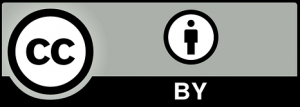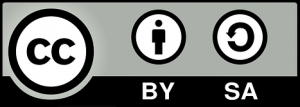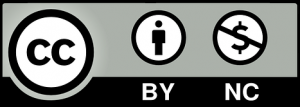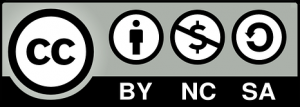20 Creative Commons licenses
Creative Commons licenses are what we use to let people know how they can use the work we have created.
These licenses act as explicit, standing permissions for all users. Learn about Creative Commons licenses in the video below:
The Four Components of a Creative Commons License
| Attribution (BY) Proper attribution must be given to the original creator of the work whenever a portion of their work is reused or adapted. This includes a link to the original work, information about the author, and information about the original work’s license. | |
| Share-Alike (SA) Iterations of the original work must be made available under the same license terms. | |
| Non-Commercial (NC) The work cannot be sold at a profit or used for commercial means such as for-profit advertising. Copies of the work can be purchased in print and given away or sold at cost. | |
| No Derivatives (ND) The work cannot be altered or “remixed.” Only identical copies of the work can be redistributed without additional permission from the creator. |
These elements can be mixed and matched to create a total of six Creative Commons licenses.[1]
Choosing a license
Choosing a CC license can be confusing at first, but the online Choose a License tool can help. This tool generates a license based on which rights you want to retain and which you would like to give to users. Faculty may ask you about Creative Commons licensing. It’s also important to understand how materials that have a CC license can and can not be used or reused.
Before you choose a license, keep in mind that an OER should be able to exercise all the 5 Rs of open content we discussed in the previous chapter. Not all of the CC licenses meet this definition. Specifically, the CC BY-ND and CC BY-NC-ND licenses do not allow revising or remixing content, two of the most significant freedoms of OER for many instructors.

Implementing a license
Creative Commons has an online Marking Guide that demonstrates how to mark your CC license on different types of media. Making your license obvious on whatever item you are sharing is an important part of the dissemination process for OER: otherwise, users won’t know what license you’ve chosen! No matter the format, there are some standards you can follow:
- Make it clear
- Make it visible
- Provide links (to the license and the work)
The Six CC licenses
The parts of a Creative Commons license
There are strengths and weaknesses to each Creative Commons license you might apply to your OER. To help you make an informed decision, a short description of each license that can be applied to OER is provided below.
 CC BY
CC BY
Strengths
- The CC BY license is the most popular and open license provided by Creative Commons.
- By requiring attribution and nothing else, your CC BY work will be easy for others to adapt and build upon.
- CC BY is often the default choice for open publications. Youtube uses the CC BY 3.0 license as their single “Creative Commons” option.
Weaknesses
- Because CC BY allows for easier sharing and adaptation, it also leaves the creator with less power over their work. When you use a CC BY license, you cannot be certain that your work will remain open or that your work will be reused for projects you support.
 CC BY SA
CC BY SA
Strengths
- The CC BY SA combines the openness of CC BY license with the caveat that an item remains open under the same license when adapted.
- The CC BY SA license is the second most popular license, and the license used by Wikipedia for their articles.
Weaknesses
- Because the CC BY SA license requires that adapted content be shared under the same license, it can be difficult to adapt or to remix works licensed CC BY SA.[2]
 CC BY NC
CC BY NC
Strengths
- The CC BY NC license gives the creator of a work complete control over any commercial reuse of their work.
- As a user, you can adapt and remix CC BY NC works so long as your new works provide attribution to the original author and do not turn a profit.
Weaknesses
- Some users may be concerned about what they are allowed to do with your CC BY NC work and where the commercial “line” is drawn. This topic is addressed in more depth in our OER in Print chapter.
 CC BY NC SA
CC BY NC SA
Strengths
- CC BY NC SA is the most restrictive license that can be used for OER and gives you the most control over its adaptations.
- Some creators apply this license out of concern for their works being “scooped” by commercial publishers.
Weaknesses
- Because of its requirements, the CC BY NC SA license is the hardest to adapt, remix, or build upon.
- If you hope to leverage the open community to promote and share your content, this license may be a deterrent for potential partners.
You can learn more about the individual CC licenses on the Creative Commons website.
If you want to reuse an existing OER, there are some aspects of CC licenses you should keep in mind. Although there are different rules for each, every CC license includes the Attribution component which requires that users provide proper attribution for an original work being shared or adapted.
Video – Creating OER and Combining Licenses

